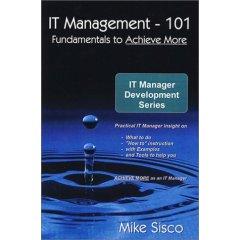| 2020ok Directory of FREE Online Books and FREE eBooks |
Free eBooks > Home & Garden > How-to & Home Improvements > Cleaning, Caretaking & Relocating > It Management 101
It Management 101by Mike Sisco  Download Book (Respecting the intellectual property of others is utmost important to us, we make every effort to make sure we only link to legitimate sites, such as those sites owned by authors and publishers. If you have any questions about these links, please contact us.) link 1 About Book Book Description IT Management-101 provides practical insight on what you need to do to function successfully in any IT Manager role. The book starts with a discussion on conducting an effective technology assessment and leads into eleven management traits necessary to be a successful IT manager. From the Publisher Mike Sisco is a former CIO of more than twenty years. His company, MDE Enterprises, is dedicated to the development of IT managers so they achieve greater success. MDE Enterprises provides IT management content, tools, and IT management training and consulting services. Mr. Sisco writes articles for technology communities and shares his experiences and insight in an easy going, conversational style that gets to the point quickly. He has significant experience in the acuisition and assimilation activities surrounding company acquisitions and has written other works on key topics of IT management. His book IT Management-101 is one of few works that you will find that is written from a very simplistic and practical point of view. Easy reading and easy to follow; this book is a must have for all IT managers.
I hope you enjoy the read and have fun along the way in your IT management career. Written in a conversational style with plenty of real life examples, it will be one of the more enjoyable management books you will read.
Mike graduated from the University of Tennessee at Martin with a BS degree in Business Administration. He also played on the golf team at UTM and in the Marine Corps. At IBM, Mike gained considerable insight into small business by installing and selling IBM systems and applications in six industries. Mike's management career has included the management of large distributed IT organizations up to 300 people, turnaround situations, a startup, and high growth companies. He has considerable experience in IT due diligence having performed the technology assessment of more than 35 companies to support acquisitions. Mike's strengths as a CIO are in conducting a thorough IT assessment that defines the goals and objectives of the company, quantifies the technology issues, prioritizes the initiatives that best support the business, and focuses the IT resources in a manner that is in sync with company needs. His management style is one that empowers employees to achieve more and that helps them to take charge of their destiny.
1. Focus initially in understanding what the company is trying to achieve. Every decision you make later should be supportive in one way or another to support your company’s objectives. 2. Develop an understanding of key department objectives required to support the business. 3. Work with your senior IT managers to identify the IT objectives required to support the company and its key departments in meeting company goals. 4. Relate the IT organization objectives to your specific department responsibilities. Involve your senior IT managers as needed to develop a concise strategy that fully supports the company’s plans. Using others that have more experience is actually a strength, not a weakness. Not doing so and failing to anticipate issues that are critical to success is a weakness. B. Role needed for the IT Manager to Play "You need me to manage, right ?" The answer is not always a simple ‘yes’ or ‘no’. Every IT organization has a unique set of dynamics. While there are definitely skills or traits that will work in most organizations, it’s also important to understand the role that is needed in the specific position you have. For example, an organization that is mature and has sound processes in place and has experienced resources needs an entirely different management mindset than the organization that is struggling to find its way. Relate this to military terms and it’s a difference in needing to ‘take the beach’ versus coming in behind the early force to ‘cleanup’. Learning the type of management style needed for your specific IT organization early on helps you go about your work in the best manner to gain the results needed for the company. When I pick up a new organization I go about assessing what I have, what are the issues and challenges, and what type of strategy is needed to support my company to the fullest. You will better understand the management role you need to provide as you go through the assessment phase discussed next. As you go through an assessment, you want to look for indicators that tell you the type of role needed. As you’re learning about the company and it’s IT needs, you’re also looking for indications as to whether you are part of an "initial assault team" or the type of manager that just needs to fine tune the existing organization. Related Free eBooks | Related Tags |












SEND A COMMENT
PLEASE READ: All comments must be approved before appearing in the thread; time and space constraints prevent all comments from appearing. We will only approve comments that are directly related to the article, use appropriate language and are not attacking the comments of others.